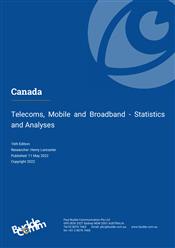Canada Telecoms Market Report
Telecoms, Mobile and Broadband - Statistics and Analyses

Canada concludes another 5G spectrum auction
The Canadian telecom market continues to show steady development as operators invest in network upgrades. Much of the investment among telcos has been channelled into LTE infrastructure to capitalise of consumer demand for mobile data services, while there has also been further investment in 5G. Investment programs have also been supported by regulatory efforts to ensure that operators have spectrum available to develop 5G services. Spectrum in the 600MGz and 3.5GHz ranges has already been auctioned, while other auctions are planned through to 2024. In the 3.5GHz range the regulator set aside 50MHz for new entrants to encourage competition in the wireless segment.
There has also been a concentration of investment in fixed-line infrastructure, focussed on FttP and, among cable broadband providers, upgrades to the DOCSIS3.1 standard. This is having the effect that the DSL segment is steadily losing market share as customers are migrated to fibre. Telus expected to have completely decommissioned its copper network by the end of 2022.
Government policy has encouraged the extension of broadband to rural and regional areas, with the result that services are almost universally available and the emphasis now is on improving service speeds to enable the entire population to benefit from the digital economy and society. Cable broadband is the principal access platform, followed by DSL. The main cablecos are upgrading their networks to the DOCSIS3.1 standard, which can deliver data at 1Gb/s and above. Fibre deployments are also gaining momentum, with a growing number of Gigabit towns now connected.
The mobile penetration rate remains comparatively low by international standards, and so the market offers further room for growth. Canadians are well provided for LTE and LTE-A infrastructure. Despite topographical challenges and the remoteness of many areas, the major players effectively offer 99% population coverage with LTE. In the 5G segment, Telus and Bell Wireless were early triallists, followed by Shaw Communications in May 2018. Operators now provide up to 70% population coverage with 5G.
The government has endeavoured to encourage market competition by ensuring that blocks of spectrum have been reserved for new entrants, while preventing deals among operators which would have concentrated spectrum either regionally or nationally. About 43% of spectrum to be auctioned in the 600MHz band has been reserved for smaller operators in a bid to encourage competition.
This report provides a broad range of key statistical data on the major telecoms segments, as well as developments in e-commerce and e-health, and policies which support the adoption of smart meters and the progress of smart grids. It provides an overview of each major sector, an analysis of market developments and an assessment of operator strategies. The report also covers the mobile voice and data markets, as well as the fixed-line and fixed-wireless broadband sectors.
Key developments:
- Google announces plan to lay the Topaz subsea cable connecting Canada to Japan, to be lit in 2023;
- Second phase of the Connecting Families project is launched;
- Telus calculates savings to be made from decommissioning copper infrastructure;
- Rogers’ 5G network using LiDAR sensors to monitor city vehicle and pedestrian traffic;
- Rogers and Shaw gain approvals for their merger;
- Federal Court of Appeals directs incumbents to establish fair wholesale internet rates;
- ISED approves AWS-3 spectrum sharing agreement between Bell and Telus;
- Value of Canadian e-commerce transactions grew 17.9% in 2021;
- Report update includes the regulator’s 2020 telecom monitoring report, operator data to February 2022, recent market developments.
Companies mentioned in this report:
Rogers Wireless, Bell Mobility, Virgin Mobile Canada, Telus Mobility, SaskTel Mobility, MTS Allstream, Freedom Mobile, Mobilicity, Public Mobile, Vidéotron Wireless, Shaw Communications, Bell Canada, Bell Aliant, BOLDstreet Wireless, Tadaa Wireless, DoDo Wireless, Hotspotzz, Wayport, Boingo, FatPort, Rogers Communications, Craig Wireless System, Barrett Xplore, I-NetLink, SaskTel, Vidéotron, Shaw Cablesystems, Rogers Cable Communications, Cogeco Cable.
Related Reports
Share this Report
TMT Intelligence
A platform to scale your intelligence tasks
Monitor critical insights with our AI-powered Market Intelligence Platform gathering and analyzing intelligence in real time. With AI trained to spot emerging trends and detect new strategic opportunities, our clients use TMT Intelligence to accelerate their growth.
If you want to know more about it, please see:
Research Methodology
BuddeComm's strategic business reports contain a combination of both primary and secondary research statistics, analyses written by our senior analysts supported by a network of experts, industry contacts and researchers from around the world as well as our own scenario forecasts.
For more details, please see:
More than 4,000 customers from 140 countries utilise BuddeComm Research
Are you interested in BuddeComm's Custom Research Service?
Hot Topics
News & Views
Have the latest telecommunications industry news delivered to your inbox by subscribing to BuddeComm's weekly newsletter.